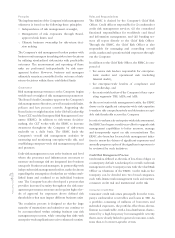American Express 2004 Annual Report Download - page 36
Download and view the complete annual report
Please find page 36 of the 2004 American Express annual report below. You can navigate through the pages in the report by either clicking on the pages listed below, or by using the keyword search tool below to find specific information within the annual report.
program. Past behavior is used to predict when current
enrollees will leave the program and their ultimate
redemption rate.
The provision for the cost of Membership Rewards is
based upon points earned that are ultimately expected
to be redeemed by cardmembers and the current
weighted-average cost per point of redemption. The
weighted-average cost per point is affected by the mix
of rewards redeemed. The provision and related bal-
ance sheet reserve for unredeemed points are
impacted over time based on a number of factors
including changes in the number of cardmembers in
the Membership Rewards program, the actual amount
of points earned and redeemed, the actual weighted-
average cost per point, the availability of Membership
Rewards offerings by vendors, the redemption choices
made by cardmembers, and future changes the Com-
pany could make to the program. As of December 31,
2004, if the ultimate redemption rate changed by 100
basis points, the reserve for Membership Rewards
would change by approximately $130 million.
Asset securitizations
Securitization of the Company’s cardmember receivables
and loans is accomplished through the transfer of those
assets to a special purpose entity created for the securi-
tization, generally a trust, which in turn issues securities
that are collateralized by the transferred assets to third-
party investors. The Company accounts for its securitiza-
tion activities as either sales or secured borrowings in
accordance with Statement of Financial Accounting
Standards (SFAS) No. 140, “Accounting for Transfers and
Servicing of Financial Assets and Extinguishments of
Liabilities — a Replacement of FASB Statement No. 125.”
During 2004, the Company recognized $26 million in net
pretax gains from securitizations.
Management utilizes certain estimates and assump-
tions to determine the fair value of the Company’s sub-
ordinated retained interests, including an interest-only
strip, and gains or losses at the time of sale. These esti-
mates and assumptions are generally based on projec-
tions of finance charges and fees paid related to the
securitized assets, net credit losses, average loan life,
the contractual fee to service the securitized assets and
a discount rate commensurate with the retained inter-
ests. Changes in the estimates and assumptions used
may have an impact on the Company’s gain or loss
calculation and the valuation of its subordinated
retained interests. As of December 31, 2004, the total
fair value of all subordinated retained interests was
$315 million. A 10 percent adverse change in the key
estimates and assumptions would result in a decrease
in the total fair value of approximately $34 million.
Investment securities valuation
Generally, investment securities are carried at fair value
on the balance sheet with unrealized gains (losses)
recorded in accumulated other comprehensive income
(loss) within equity, net of income tax provisions (ben-
efits). At December 31, 2004, the Company had net
unrealized pretax gains on Available-for-Sale securities
of $1.3 billion. Gains and losses are recognized in
results of operations upon disposition of the securities.
Losses are also recognized when management deter-
mines that a decline in value is other-than-temporary,
which requires judgment regarding the amount and
timing of recovery. Indicators of other-than-temporary
impairment for debt securities include issuer down-
grade, default or bankruptcy. The Company also con-
siders the extent to which cost exceeds fair value, the
duration and size of that gap, and management’s judg-
ment about the issuer’s current and prospective finan-
cial condition. Approximately 90% of the investment
portfolio classified as Available-for-Sale or trading is
determined by quoted market prices. As of
December 31, 2004, there were $260 million in gross
unrealized losses that related to $18.3 billion of secu-
rities, of which $3.2 billion has been in a continuous
unrealized loss position for 12 months or more. As part
of its ongoing monitoring process, management has
determined that substantially all of the gross unrealized
losses on these securities is attributable to changes in
interest rates. Additionally, the Company has the ability
and intent to hold these securities for a time sufficient
to recover its amortized cost and has, therefore, con-
cluded that none of these securities is other-than-
temporarily impaired at December 31, 2004.
Included in the Company’s investment portfolio dis-
cussed above are structured investments of various
asset quality, including collateralized debt obligations
(CDOs) (backed by high-yield bonds and bank loans),
which are not readily marketable. The carrying values
of these structured investments are based on future
cash flow projections that require a significant degree
of management judgment as to the amount and timing
of cash payments, defaults and recovery rates of the
underlying investments and, as such, are subject to
change. The carrying value will vary if the actual cash
flows differ from projected due to actual defaults or
changes in estimated default or recovery rates. As an
example, an increase in the near-term default rate by
100 basis points, in and of itself, would reduce the cash
flow projections by approximately $10 million based
AXP
AR.04
34
Financial Review
























